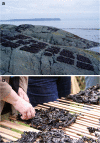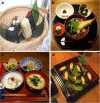Algae as nutritional and functional food sources: revisiting our understanding
- PMID: 28458464
- PMCID: PMC5387034
- DOI: 10.1007/s10811-016-0974-5
Algae as nutritional and functional food sources: revisiting our understanding
Abstract
Global demand for macroalgal and microalgal foods is growing, and algae are increasingly being consumed for functional benefits beyond the traditional considerations of nutrition and health. There is substantial evidence for the health benefits of algal-derived food products, but there remain considerable challenges in quantifying these benefits, as well as possible adverse effects. First, there is a limited understanding of nutritional composition across algal species, geographical regions, and seasons, all of which can substantially affect their dietary value. The second issue is quantifying which fractions of algal foods are bioavailable to humans, and which factors influence how food constituents are released, ranging from food preparation through genetic differentiation in the gut microbiome. Third is understanding how algal nutritional and functional constituents interact in human metabolism. Superimposed considerations are the effects of harvesting, storage, and food processing techniques that can dramatically influence the potential nutritive value of algal-derived foods. We highlight this rapidly advancing area of algal science with a particular focus on the key research required to assess better the health benefits of an alga or algal product. There are rich opportunities for phycologists in this emerging field, requiring exciting new experimental and collaborative approaches.
Keywords: Algal foods; Antioxidants; Arsenosugars; Experimental design; Microalgal supplements; Nutritional minerals; Omega-3-fatty acids; Polysaccharides; Sea vegetables; Vitamins.
Figures






References
-
- Admassu H, Zhao W, Yang R, Gasmalla M, Alsir E. Development of functional foods: seaweeds (algae) untouched potential and alternative resource—a review. Int J Sci Technol Res. 2015;4:108–115.
-
- Albanes D, et al. Effects of alpha-tocopherol and beta-carotene supplements on cancer incidence in the alpha-tocopherol beta-carotene cancer prevention study. Am J Clin Nutr. 1995;62:S1427–S1430. - PubMed
Publication types
LinkOut - more resources
Full Text Sources
Other Literature Sources
